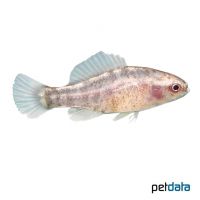Okefenokee Pygmy Sunfish (Elassoma okefenokee)
| Okefenokee Pygmy Sunfish Elassoma okefenokee | |
|---|---|
| Name | Okefenokee Pygmy Sunfish |
| Name Lat. | Elassoma okefenokee |
| Family | Pygmy Sunfishes |
| Family lat. | Elassomatidae |
| Order | Basses |
| Order lat. | Centrarchiformes |
| Origin | SE-USA |
| Habitat | Streams, ponds |
| Diet | Omnivore |
| pH | 6.0-7.0 |
| Behavior | Peaceful |
| Keeping | Group |
| Care Level | Moderate |
| Reproduction | Egg scatterer |
| Breeding | Moderately difficult |
| Life Span | 5-8 years |
| Protection | No |
| Metric Units | |
| Size | 3.5 cm |
| Temperature | 15-25 °C |
| Hardness | 5-15 °dH |
| Aquarium | 50 l |
| US Units | |
| Size | 1.4" |
| Temperature | 59-77 °F |
| Hardness | 89-267 ppm |
| Aquarium | 15 gal |
Distribution and habitat
The range of the Okefenokee Dwarf Bass extends from the lower Altamaha River in Georgia to central Florida. There they live in shallow, weedy streams as well as in ponds and pools with dense underwater vegetation and muddy bottoms.
Maintenance
The aquarium should have a dense border and background planting, with roots and stones, which serve as hiding and retreat possibility as well as offer free swimming space. A dark, sandy substrate covered with some foliage (sea almond tree, oak), some subdued light (floating plants), a weak current and soft, slightly acidic water is ideal.
No ammonia, ammonium and nitrite should be detectable, and the nitrate value should not exceed 100 mg/l. To ensure the water quality and oxygen content, a filter and heater adapted to the aquarium size is required, as well as lighting for the species-appropriate day-night rhythm of the animals.
Diet
The food supply consists of live food, such as daphnia, cyclops, artemia, mysis, tubifex and red mosquito larvae, which is also accepted in frozen form without any problems, or a commercially available frozen special food mixture supplemented with some vegetable food such as algae leaves. Also high-quality dry food (pellets, granules) is usually well accepted.
It is recommended to feed small portions several times a day. Regular and varied feeding promotes health and increases resistance. Only as much should be fed as is eaten immediately (in a maximum of 10 minutes).
Behaviour and compatibility
Okefenokee Dwarf Cichlids should be kept in pairs or in a group of 4-5 individuals. They occupy a small territory which they defend, so keeping several pairs or a group is recommended only in a larger and richly structured tank. They can also be socialized with other calm, not too large fish.
Basically, only compatible fish species with similar requirements for water conditions and water temperature should be socialized.
Sex dimorphism
The male shows a strong black-blue coloration especially at spawning time, while the female is inconspicuously brownish in color.
Reproduction and breeding
The female spawns 20-30 eggs between water plants, which are guarded by the male. After 2-3 days the larvae hatch and after another 5-6 days, when the yolk sac is consumed, the young fish swim free. They are already sexually mature after about 3 months.
Fry must be fed several times a day with special rearing food (liquid or dust food, Artemia nauplii). In community tanks breeding is hardly possible, because the young fish are easy prey.
Important
In the summer months it is possible to keep them in the pond. They are not hardy and therefore not suitable for year-round keeping in the garden pond.
They show their most beautiful coloration by feeding with live food
The foliage (sea almond tree, oak, etc.) not only provides cover, but when rotting promotes the development of microorganisms, which are a valuable secondary food source.
The well-being of the fish should be monitored regularly. Temperature should be checked daily, pH, hardness and nitrate levels at least every 14 days. Regular partial water changes are recommended, even when contaminant levels have not yet reached the upper limit. Sudden changes in water quality should be avoided. Newly introduced fish must be accustomed slowly to the water in the aquarium.
Further literature can be found in your pet store.
References
Text: Werner Winter; Image: petdata
Source: BMELV (1998): Tierschutzgutachten - Haltung von Zierfischen (Süßwasser); BAENSCH & RIEHL (2004): Aquarien Atlas Bd. 2, Mergus Verlag; ENGELMANN (2005): Zootierhaltung - Tiere in menschlicher Obhut: Fische, Verlag Harri Deutsch
- Gemäß § 21 Abs. 5 Tierschutzgesetz idgF
